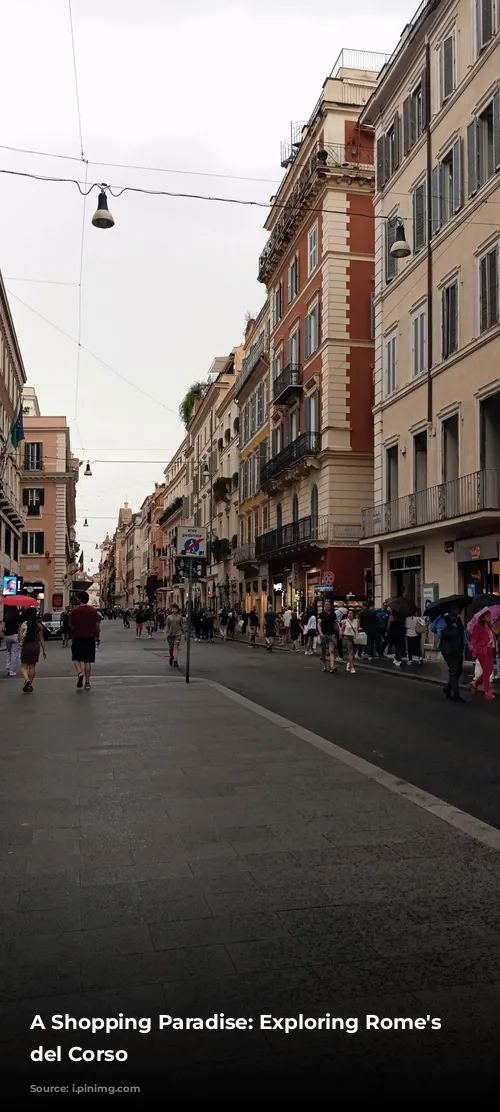Imagine strolling along a bustling street, lined with shops brimming with treasures for every taste and budget. This is the essence of Via del Corso, a vibrant thoroughfare in the heart of Rome. Connecting two iconic squares, Piazza Venezia and Piazza del Popolo, it’s a shopper’s paradise, offering everything from renowned designer brands to more affordable finds. This lively street is also a central part of the “Trident”, a trio of roads that emerged in the 15th and 17th centuries, linking Porta del Popolo with three major basilicas: St. Peter’s in the Vatican, St. John Lateran, and Saint Mary Major.
Luxury and Glamour on Via del Corso
For those seeking luxury and high fashion, Via del Corso is a gateway to a world of elegance. Turn a corner, and you’ll find yourself on Via dei Condotti, a street renowned for its glamorous boutiques showcasing the most fashionable brands. It’s like stepping into a fashion magazine, where the beauty of the craftsmanship and the exquisite items on display truly captivate the senses.
But the allure doesn’t stop there. Streets like Via Borgognona, Via della Vite, Via Frattina, Via delle Carrozze, and Via Vittoria also beckon with their own distinct charm, each offering a unique glimpse into the world of high fashion. Each street feels like a curated collection of stylish boutiques and ateliers, a testament to the artistry and ingenuity of Italian fashion.
The Heart of History: The Galleria Alberto Sordi
As you meander along Via del Corso, you’ll encounter a true architectural gem – the Galleria Alberto Sordi. This historic gallery, nestled about halfway down the street, is a captivating example of Art Nouveau architecture. Its intricate details and elegant design transport you back to a bygone era, making it a must-see for art and architecture enthusiasts.
A Journey Through Time: The Evolution of Via del Corso
Via del Corso’s story is deeply intertwined with the history of Rome. Its roots trace back to the ancient Via Flaminia, a major road that connected Rome to the north. Later known as Via Lata, it played a significant role in the Roman Empire, even serving as a burial ground for notable individuals like Emperor Augustus and Nero. However, during the Middle Ages, the road fell into disrepair, primarily due to frequent flooding of the Tiber River.
A Renaissance of Celebration: The Birth of Carnival on Via del Corso
The street’s revival came in the mid-15th century, thanks to Pope Paul II, a lover of grandeur. He established his residence in the magnificent palace in Piazza Venezia, revitalizing the surrounding area. Via del Corso became the center of Carnival festivities, transforming into a stage for extravagant parades and exciting competitions. In 1466, the first grand Carnival celebrations took place, featuring allegorical parades that drew inspiration from Roman traditions and classical mythology. The street’s straight path also lent itself perfectly to exciting competitions, leading to its renaming from Via Lata to Via del Corso, a name that directly references the spirited carnival races that took place there.
Pope Paul II instituted races on eight non-holiday days during Carnival, with participants including horses, donkeys, and buffaloes. Children, elders, and even Jews took part in the boisterous spectacle, reflecting the wild and playful spirit of the original Carnival. Though the festivities were partially curtailed in 1667 by Pope Clement IX, the traditions of the Carnival continued to shape the character of Via del Corso.
The Thrilling Races of Berber Horses
Among the most anticipated races on Via del Corso was the Berber horse competition, which endured almost unchanged until 1882. These fast thoroughbreds, hailing from Africa, were meticulously selected and trained for the races, charging down the straight towards Piazza Venezia amidst a sea of cheering spectators. The excitement of the races was further heightened by the participation of prominent Roman aristocratic families, such as the Altemps, Gabrielli, and Rospigliosi, who owned and raced the horses.
A Street With Many Names: A Reflection of Changing Times
Via del Corso’s name has undergone transformations throughout history, mirroring the changing political and social landscape of Rome. Following the assassination of King Umberto I of Savoy in 1900, the street was renamed Corso Umberto. In 1944, it was changed again to Corso del Popolo, but only two years later, it reverted back to its current name. Each name change reflects a significant moment in Roman history, further deepening the street’s rich tapestry.
A Legacy of Culture and History: The Gems of Via del Corso
Via del Corso boasts a collection of architectural and cultural treasures, encompassing palaces, churches, and monuments that tell the story of Rome. Standing tall on the street is Palazzo Bonaparte, a 17th-century palace that once housed Letizia Ramolino, Napoleon Bonaparte’s mother, and now showcases prestigious art exhibitions. The Doria-Pamphilj palace, a grand building housing the extraordinary Doria-Pamphilj Gallery, further adds to the street’s artistic heritage.
Churches like San Marcello al Corso, the basilica of Santi Ambrogio e Carlo al Corso, with its dome by the renowned Pietro da Cortona, and the Sciarra Gallery, a surprising and delightful architectural gem, add to the street’s captivating charm. Even the house-museum of German poet Johann Wolfgang von Goethe, located at number 18, contributes to the street’s literary legacy.
Via del Corso: A Living Tapestry of History and Culture
Walking down Via del Corso is not just a shopping experience; it’s a journey through time, each step revealing a new layer of history, art, and culture. From its humble beginnings as an ancient Roman road to its status as the heart of Carnival and a destination for luxury shopping, Via del Corso remains a captivating artery of Roman life, reflecting the city’s vibrant past, present, and future. As you stroll along this iconic street, take a moment to appreciate the stories etched in every stone, every window, and every corner, for they offer a glimpse into the soul of Rome itself.
